1828 ship
In 1828, William Fawcett of Liverpool and Joseph Robinson Pim of Dublin commissioned the construction of a paddle steamer named William Fawcett. The ship was built by Caleb and James Smith at the Queen's Dock, Port of Liverpool. Initially, the vessel measured 130 feet (40 m) in length and had a cargo capacity of 185 tons. However, in 1835, its length was recorded as 44.42 meters (145.7 ft), with a gross register tonnage of 206. The steam engines, rated at 130 horsepower, were provided by the firm of Fawcett, Preston, and Company, of which William Fawcett was a co-owner and manager. The ship operated in the packet trade, serving the routes between London, Cork and Dublin. In 1832, the vessel was sold to Richard Bourne and his associates for service with the Dublin and London Steam Packet Company. [1] [2]
In 1835, Bourne partnered with Brodie McGhie Willcox and Arthur Anderson to charter the William Fawcett for five voyages between London and the Iberian Peninsula. This service is regarded as the beginning of the Peninsular Steam Navigation Company, which later became the P&O. The first four trips of the William Fawcett for the Peninsular company in 1835 turned around at Lisbon. The fifth trip reached Gibraltar. In 1837 and again in early 1838, the ship was chartered by the Peninsular company for a trip from London to northern Spain and return. The ship was refitted later in 1838, and afterwards chartered by the Peninsular company for two trips between London and Madeira. The William Fawcett had been broken up by April 1845. [2]

A steamship, often referred to as a steamer, is a type of steam-powered vessel, typically ocean-faring and seaworthy, that is propelled by one or more steam engines that typically move (turn) propellers or paddlewheels. The first steamships came into practical usage during the early 1800s; however, there were exceptions that came before. Steamships usually use the prefix designations of "PS" for paddle steamer or "SS" for screw steamer. As paddle steamers became less common, "SS" is assumed by many to stand for "steamship". Ships powered by internal combustion engines use a prefix such as "MV" for motor vessel, so it is not correct to use "SS" for most modern vessels.
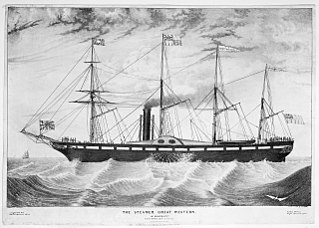
SS Great Western of 1838, was a wooden-hulled paddle-wheel steamship with four masts, the first steamship purpose-built for crossing the Atlantic, and the initial unit of the Great Western Steamship Company. She was the largest passenger ship in the world from 1837 to 1839, the year the SS British Queen went into service.
The shipping company is an outcome of the development of the steamship. In former days, when the packet ship was the mode of conveyance, combinations, such as the well-known Dramatic and Black Ball lines, existed but the ships which they ran were not necessarily owned by the organizers of the services. The advent of the steamship changed all that.

The City of Dublin Steam Packet Company was a shipping line established in 1823. It served cross-channel routes between Britain and Ireland for over a century. For 70 of those years it transported the mail. It was 'wound-up' by a select committee of the House of Lords in 1922 and finally liquidated in 1930.
The West Cornwall Steam Ship Company was established in 1870 to operate ferry services between Penzance, Cornwall, and the Isles of Scilly. It became the West Cornwall Steamship Company in 1907 and was wound up in 1917.

SS Sirius was a wooden-hulled sidewheel steamship built in 1837 by Robert Menzies & Sons of Leith, Scotland for the London-Cork route operated by the Saint George Steam Packet Company. The next year, she opened transatlantic steam passenger service when she was chartered for two voyages by the British and American Steam Navigation Company. By arriving in New York a day ahead of the Great Western, she is usually listed as the first holder of the Blue Riband, although the term was not used until decades later.
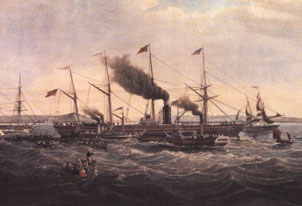
The Great Western Steam Ship Company operated the first regular transatlantic steamer service from 1838 until 1846. Related to the Great Western Railway, it was expected to achieve the position that was ultimately secured by the Cunard Line. The firm's first ship, Great Western was capable of record Blue Riband crossings as late as 1843 and was the model for Cunard's Britannia and her three sisters. The company's second steamer, the Great Britain was an outstanding technical achievement of the age. The company collapsed because it failed to secure a mail contract and Great Britain appeared to be a total loss after running aground. The company might have had a more successful outcome had it built sister ships for Great Western instead of investing in the too advanced Great Britain.
The British and American Steam Navigation Company was a steamship line that operated a regular transatlantic service from 1839 to 1841. Before its first purpose-built Atlantic liner, British Queen was completed, British and American chartered Sirius for two voyages in 1838 to beat the Great Western Steamship Company into service. B & A's regular liners were larger than their rivals, but were underpowered. The company collapsed when its second vessel, President was lost in 1841.

SS Archimedes was a steamship built in Britain in 1839. She was the world's first steamship to be driven successfully by a screw propeller.
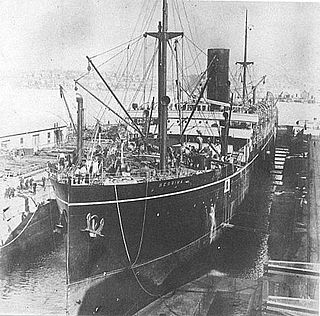
Caird & Company was a Scottish shipbuilding and engineering firm based in Greenock. The company was established in 1828 by John Caird when he received an order to re-engine Clyde paddle-tugs.

The Drogheda Steam Packet Company was founded in 1826 as the Drogheda Paddle Steamship Co. It provided shipping services between Drogheda and Liverpool from 1825 to 1902, in which year it was taken over by the Lancashire and Yorkshire Railway.
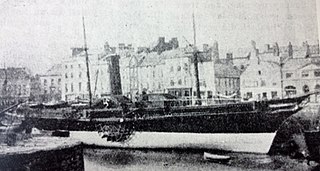
SS (RMS) Tynwald (I), No. 21921, was an iron paddle-steamer which served with the Isle of Man Steam Packet Company, and was the first vessel in the Company to bear the name.

SS (RMS) Queen of the Isle was a paddle steamer which was constructed by Robert Napier & Co. Glasgow. No Official number is recorded for the vessel, as formal registration was not introduced until the Merchant Shipping Act 1854.
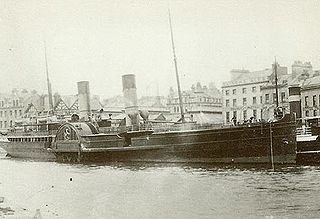
SS (RMS) Snaefell (II) No. 67289 – the second vessel in the line's history to be so named – was an iron paddle steamer which was owned and operated by the Isle of Man Steam Packet Company.

SS (RMS) Mona (III), the third ship of the Company to bear the name, was a steel paddle-steamer which was originally owned and operated by the London, Chatham and Dover Railway Company, who then sold her to the Liverpool and Douglas Steamship Company, from whose liquidators she was acquired by the Isle of Man Steam Packet Company in 1903.

The Merlin-class packet boat of 1838 was a Sir William Symonds design that was approved on 2 April 1838. The vessels were to be built for steam mail packet service on the Liverpool to Dublin route. The initial two ships were ordered in the fall of 1838 from Pembroke Dockyard. The third vessel (Medina) was ordered in 1839, also from Pembroke. When completed all vessels were used on the Liverpool station. In 1848 all three were in the Mediterranean on mail packet service. Merlin went to the Baltic during the Russian Was as a survey ship. Medusa went to the Black Sea. Medina remained in the Mediterranean being converted to a survey ship for Mediterranean service. Merlin served on the West Coast of Africa and was sold for commercial use in 1863. Medina was sold at Malta in April 1864. Medusa was converted to a tugboat in 1861 and remained in that service until sold in 1872.
Water Witch was an early British wood-hulled paddle steamer, built in 1835 at Harwich, England for steam packet services from Dover to London and to Boulogne. A successful fast ship, she was later operated on services on the South Coast of England and in the Bristol Channel
William Fawcett was an engineer and manufacturer of guns and steam engines, supplying steam engines for some of the earliest steam ships in Britain and America, and for use on sugar plantations in America. He was a partner in the firm of Fawcett, Preston and Company, which supplied the steam engines for a number of ships, including the paddle steamer William Fawcett, described as the first ship operated by what would become the Peninsular and Oriental Steam Navigation Company (P&O).
Marchioness Wellesley was a packet paddle steamer launched in 1826 for the Dublin and Wexford Steam Co. She operated out of Dublin and was last listed in 1838.
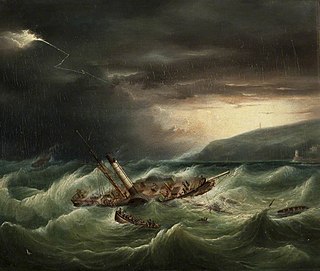
The first RMS St Patrick of the St. George Steam Packet Company was a wooden paddle steamer, launched by Mottershead & Hayes of Liverpool on 22 April 1822 for passenger service. The ship first served on the line's Dublin to Liverpool route, with a stopover in Bristol. The ship was sold in 1824 to Portuguese interests and renamed the ship Restaurador Lusitano, which operated on the Lisbon to Oporto route. Civil war broke out in 1828 and the vessel was chartered for service by the Absolutists in 1832. While sailing with troops and supplies, Restaurador Lusitano was severely damaged in a storm while attempting to aid another vessel in trouble. The damage was too much and Restaurador Lusitano sank on 11 September 1832.














